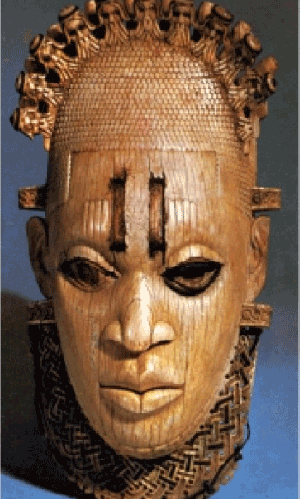Long before December 2010 when Nigerians protested in London over Sotheby’s planned sale of the famous Idia mask, there has been efforts by Nigerian authorities to repatriate the country’s stolen artefacts from different locations around the world. Some may describe such effort as lackluster, but pay day may have come, since this year has been remarkable for the return of such relics. Assistant Life Editor, TERH AGBEDEH, in this report, chronicles the trend
Idia mask
Two separate events took place last month, but are related in one respect: the return of Nigeria’s artefacts. The first involved a Briton by the name of Mark Walker. The doctor returned to the Oba of Benin two bronze works among the ones carted away by his great grandfather 117 years ago during the invasion of Benin by British soldiers.
The second took place barely a week after the first. In this case, the National Commission for Museums and Monuments (NCMM) announced the return of eight cultural objects.
Director-General of the NCMM, Yusuf Usman, said during the press briefing at the National Museum, Onikan, Lagos, recently that the Museum of Fine Art (MFA) Boston, United States, returned eight artefacts, which included works in bronze, terracotta, wood of Benin, Ife and Oron origin to Nigeria. He stated that the milestone was reached after the Ministry of Tourism, Culture and National Orientation opened dialogue with foreign museums four years ago.
Walker returned a long-beaked bird and a bell, which were removed by his great-grandfather, Capt. Philip Walker, in 1897.
The two objects were handed over to the Benin monarch, Oba Erediauwa, a great grandson of the then monarch at a reception organised in honour of the Briton in Benin.
If nothing else comes out of this, the media attention will go a long way in creating awareness about the dastardly act of pilfering these artefacts that seems to be continuing unabated.
Walker’s journey to Benin, for instance, was motivated by a website on the Benin Kingdom he gleaned online. At the National Museum gathering, for instance, Usman, who said the discussion on restitution of Nigerian artefacts was on-going, explained that more Nigerian artefacts were intercepted on the Nigeria-Seme border.
The NCMM, he said, has since taken possession of the 18 artefacts intercepted by the Nigeria Customs Service (NCS).
There is no doubt that the trade in Nigerian artefacts is a lucrative one, considering that it has been continuously reported in the media that the pillage goes on even now. There is ample evidence in the 18 artefacts, which were also on display at the museum. One incentive must be the worth of the works of art estimated to be over N300 billion.
This is, however, not the first time Nigerian artefacts have been returned to the country. In 2009, Ojo Maduekwe, who was then Foreign Affairs Minister, took delivery of two stolen Nigerian artefacts worth $55,000 that were handed over to Nigeria by the French Customs in Toulouse, France.
The two monoliths were reportedly smuggled into France in 2004 and were then valued at $55,000.
Maduekwe had said then that the decision to return the stolen stones to Nigeria underscored France’s sensitivity to the issue of works of art that were illegally removed from their countries of origin.
It appears that sensitivity is not shared by all the countries that have custody of Nigerian artefacts. The British Museum is said to be in custody of about 700 pieces, while the Ethnology Museum in Berlin holds over 500. That is not counting works from private hands like the two from Walker.
But the other side of the coin blames the Nigerian government for not putting in enough to repatriate the artefacts. Minister of Tourism, Culture and National Orientation, Edem Duke, who was also at the event, had said that as a people that hold their cultural heritage in esteem. “It is our primary responsibility to ensure the protection, security and safety of these priceless antiquities.”
Over 1,500 artefacts originating from Nigeria are nesting in different museums abroad.
But those who insist that government has not done enough to repatriate the artefacts point to the fact that the country is elected to the Subsidiary Committee of the Meeting of State Parties to the Convention on the Means of Prohibiting and Preventing the Illicit Import, Export and Transfer of Ownership of Cultural Property, but has not pulled its weight in this regard.
For Yemisi Shyllon, an art collector of repute, the attitude of Nigerian leaders towards the arts and their complacency over the question of restitution is to blame.
Shyllon said the British Museum avoids the consistent and increasing pressure for the return of the looted artworks. He is particularly irked by the response of a British official to the question of repatriation.
“He told us to rather concentrate more on the benefits accruing to us from the on-going human capacity development programme of the British Museum by the assisted training programme in England of civil servants, instead of calling for the return of the looted works,” Shyllon was quoted to have said.
However, the Berlin government’s stance on the said 507 artefacts in the Ethnology Museum, which it insists were legally acquired, is that there has not been any request from the Nigerian government for their return.
Then there is the question of the safekeeping of these artefacts in the museums in the country. This is an important issue considering that thieves still find their way into these museums and cart away the said artefacts.
It is heartening then that the Ford Foundation has stepped in with $2 million to build a National Conservation Centre at the National Museum. This amount came on the heels of the recently launched Art and Business Foundation, and it is also towards securing the objects at the National Museum in Lagos.
It is not enough to receive the artefacts that are making their way back to the country; there should be sustainable effort to keep them from once more making their way abroad.
Among the artefacts in question are more than 1,000 Benin commemorative bronze pieces that originated from the royal palace of the Benin Empire. One of such works of art that stands out is the Idia mask of the queen mother made during the reign of Oba Esigie. There are also pieces from the Nok Terracotta made by the Nok people in present-day Kaduna State. Also in the collections abroad are works of Igbo-Ukwu Bronze remarkable as an ancient city of bronze.
The repatriation of these cultural heritages, among many others, will definitely fill the yawning crack in Nigeria’s cultural stance on the global stage.











